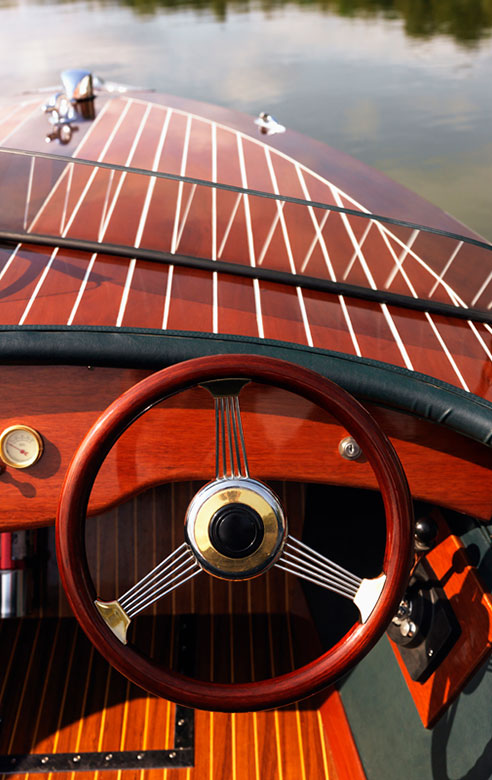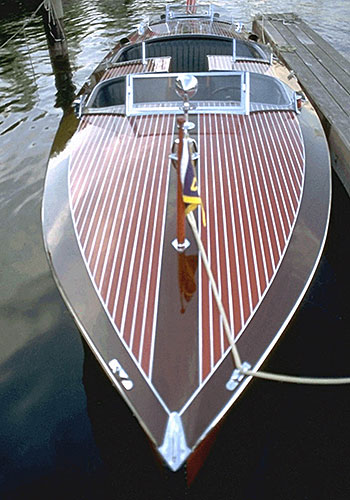



History of Classic Powerboats
- ArticlesandContent.com (CIRCA 2005)
- /
- Oct 8, 2021 (written 2005)
Powerboats – the smell of gasoline and lake water, the feel of the thunder under wood or fiberglass, liquid hardened as the bottom of your powerboat rockets across it, leaving a wide wake of sharp foam behind and a spray that lingers in the air for minutes after you’ve moved on.
We’ve all seen them, and many of us own them. But what about the old powerboats, the classic wooden boats that marked the beginning of a new era? What happened to them, where are they now, and how much are they worth? These are all questions any true aficionado would ask, and all questions certainly deserving of answers.
Throughout the decades, there have been some powerboats and powerboat manufacturers that have stood head and shoulders above the pack, producers who created products of such high quality that they are even now remembered with awe and admiration by those who know the field.
Famous Wooden Powerboats
One relatively well-known powerboat manufacturer during the first half of the twentieth century was Chris Smith, owner of the Chris Smith and Sons powerboat manufacturing company. For eight years of the company’s existence, Smith was partnered with the powerboat racer Gar Wood. Wood was famous for his racing abilities and won many of his best races in a Chris Smith and Sons wooden powerboat.
Smith went on to shape the face of the powerboat industry when he reorganized his company under the name Chris Craft, in 1922. Making most of its profits by mass producing what we would now call classic wooden boats, Chris Craft soon became one of the largest manufacturers of such craft in the world. In fact, Chris Craft is still in business – you can see samples of their work online at www.chriscraftboats.com.
Smith’s business partner, Gar Wood, wasn’t satisfied with racing another man’s boats. Wood went on after his partnership with Chris Smith and Sons to form his own powerboat manufacturing company. Wood had already made a fortune with his invention of the hydraulic lift used in dump trucks, and went on to make even more money with the formation of the Garwood Boat Company. The company never manufactured a particularly large number of powerboats, and as a result, Garwood powerboats were fairly rare and viewed as premium craft. Famous wooden powerboats made by Garwood, if still in good condition, are now viewed as classics and worth quite a lot of money.
Classic Powerboats Today
The “classic” powerboat really isn’t much different from a normal motorboat in terms of pure functionality – but that, of course, is like saying a vintage 1960 Ford Mustang really isn’t much different in functionality from a modern Ford Tempo. Classic powerboats are not classic because they are somehow fundamentally different than run of the mill motorboats, but because they are instilled with a sense of class most boats lack.
Classic wooden powerboats are (or were) built with style in mind, with polished mahogany frames that gleamed in the light and fine leather upholstery, weather proofed and waterproofed. Due to the durability and low price of fiberglass manufacturing, wooden powerboats are somewhat more rare now than they once were, but the true aficionado can find one if he or she is willing to look hard enough. The Internet is an invaluable tool in the search for the perfect classic wooden powerboat, with websites www.woodenclassics.com available for the sole purpose of uniting you with the wooden powerboat of your dreams. Even if you’re not interested in buying just yet, you can get a feel for the market and look at pictures of great wooden powerboats of the past and present.
Wood vs. Fiberglass
So what’s the difference, really, other than pure looks? Fiberglass and wood are fundamentally different construction materials, so surely there must be a difference. Don’t worry – there are, and not insubstantial ones. Wooden boats are almost always classics, so you can usually expect to pay more for a wooden boat than for a standard fiberglass model.
There is, however, a second important consideration. The moment you buy a fiberglass boat, it depreciates, sometimes as much as twenty five percent of its original price. With a wooden boat, you’ll actually see an increase in price as long as you take good care of it. Fiberglass boats also tend to break down sooner than wooden boats do.
You may be tempted to buy an old, run-down wooden powerboat and attempt to renovate it and sell it for a profit. Resist the temptation! You’ll almost always end up spending far more on the renovation than you would on the profit. Keep in mind that these classic wooden powerboats are works of art and very difficult to work with in a home environment.
Remember, whether you’re buying a brand new wooden powerboat or looking at the old ones, be prepared to spend – and be prepared to have an amazingly good time as soon as you do.
